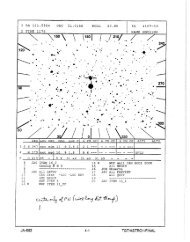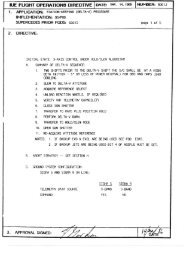The FUSE Archival Data Handbook - MAST - STScI
The FUSE Archival Data Handbook - MAST - STScI
The FUSE Archival Data Handbook - MAST - STScI
You also want an ePaper? Increase the reach of your titles
YUMPU automatically turns print PDFs into web optimized ePapers that Google loves.
NOTE 1: Two types of airglow observations were obtained during the course of the mission: i)<br />
dedicated bright-earth observations (see Chapter 9); and ii) airglow exposures obtained as part<br />
of a science program execution. Observations (i) are archived under program codes M106 and<br />
S100. Airglow exposures (ii) are archived with their respective science program codes. <strong>The</strong>y are<br />
assigned exposure numbers > 900 to distinguish them from the regular science exposures. For<br />
further details, see the NOTES in Sections 4.2.1.2, 4.2.1.3, and 4.2.2.1. A separate interface<br />
to retrieve airglow data is available at the <strong>MAST</strong> archive.<br />
NOTE 2: Separate from airglow observations are sky background observations, found in<br />
programs S405, S505, S605, S705, S805, and S905. <strong>The</strong> <strong>FUSE</strong> sky backgrounds program started<br />
in an attempt to get potentially scientifically useful data during thermalization periods prior to<br />
channel alignment activities (when normal science observing could not be done). For programs<br />
S405 and S505 targets, the alignment target was placed at the RFPT and thus the “sky”<br />
position was a randomly-accessed region roughly an arcminute away (exact position dependent<br />
on the roll angle, hence the day of observation). Multiple observations of the same target in<br />
these programs thus do not correspond exactly to the same piece of sky, but for diffuse emission<br />
it was not expected to matter very much.<br />
Beginning in 2005, after the reaction wheel problems, it became useful to define sky positions<br />
in stable regions of the sky, to provide targets for stable pointing when no regular science target<br />
was available. Again, the intent was to obtain science data from periods that would otherwise<br />
have gone to no good purpose. <strong>The</strong>se include programs S605, S705, S805, and S905. <strong>The</strong>se<br />
were all pointed observations, so the given coordinates correspond to the LWRS aperture for<br />
these observations. Hence, multiple observations in these programs correspond to the same<br />
piece of sky, albeit with a different aperture position angle (which should be negligible).<br />
It is gratifying that these observations have resulted in interesting diffuse background measurements.<br />
<strong>The</strong> reader is referred to Dixon et al. [2006] and references therein.<br />
<strong>The</strong> alignment scan observations involved stepping a star across the LWRS aperture in each<br />
channel. Correlation of photon events with pointing position and reconstruction of a spectrum<br />
may be possible. However, in most instances the effective exposure time will be short and the<br />
results will not warrant the labor involved.<br />
4.1.3 Notation Convention<br />
Because up to eight spectral files can be produced by a single <strong>FUSE</strong> exposure, and since a<br />
single observation can be composed of multiple exposures, we introduce a compressed notation<br />
to summarize the different sets of files. In the following, we depict file names as a group of<br />
italic and typewriter type faces, as indicated in Table 4.5.<br />
Table 4.5: Notation<br />
Typeface Group property<br />
italic variable which depends on a specific file<br />
typewriter always present<br />
typewriter array {} each combination is always present.<br />
Two variables that often appear in the file names are the aperture number an = {2, 3, 4}<br />
(see Table 2.1), and the data collection mode = {ttag, hist} (see Section 2.1.7). A target can<br />
22




